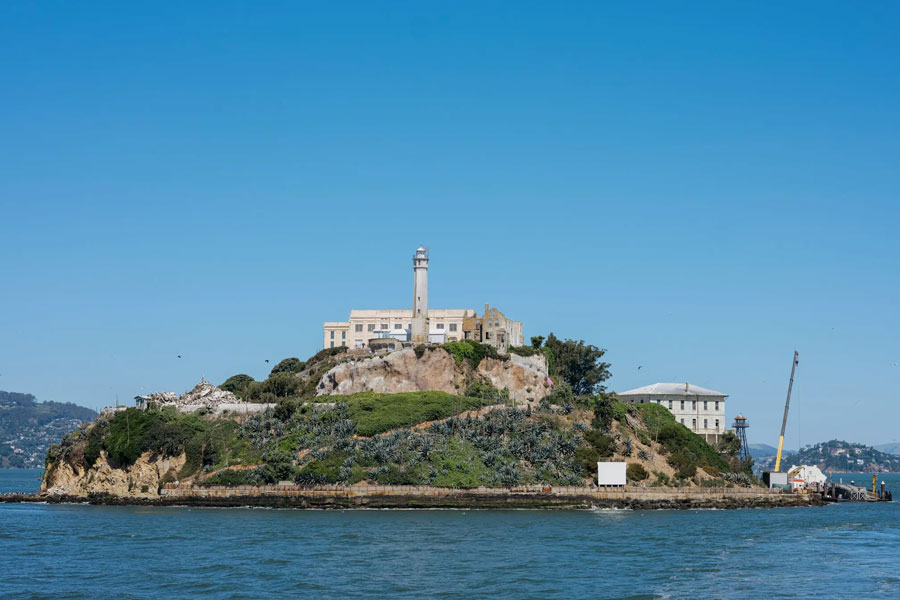Boatloads of tourists traipsed around Alcatraz Island on Monday morning and peered into tiny prison cells, learning about the most notorious inmates who stayed there — and the ones who tried to escape.
The tour was standard at the revered San Francisco attraction, save for one topic that simply could not be avoided in the conversations echoing off the old cellblock walls.
Can you believe that President Donald Trump wants to convert Alcatraz back into a federal prison?
The morning tour groups were full of international travelers, and many of them had received phone alerts about Trump’s plan or read news reports over breakfast. Some wondered if they might actually be among the last visitors allowed to wander the island. But nobody seemed to think the idea was nearly as brilliant as Trump thought it was.
“I thought it was a joke,” said Philipp Neumann, who was visiting from Germany. “It’s a ruin, isn’t it, more or less?”
A ruin, yes, with some buildings deteriorating so badly they no longer have roofs or complete walls. The cells have broken toilets, if they have any at all, with no running water or sewage system.
The exterior walls of the cellblocks are so weak that they are reinforced with netting to prevent chunks of concrete from crumbling onto tourists’ heads. Bird deposits coat much of the island. All supplies from food to fuel must be brought in by boat.
Alcatraz has been practically frozen in time since the day that the storied prison saw its last inmate 62 years ago. When the federal government closed the facility, officials had deemed it a deteriorated relic that was insufficient for housing inmates.
Since then, Alcatraz has had more success in fiction than as a functioning penitentiary. The 1962 film “Birdman of Alcatraz” landed Burt Lancaster an Academy Award nomination for best actor. “Escape From Alcatraz,” starring Clint Eastwood, was a 1979 hit that dramatized a famous attempt to flee the island. And “The Rock” was a 1996 Hollywood blockbuster that introduced Alcatraz to a younger generation of moviegoers.
It is possible that Trump had “Escape From Alcatraz” on his mind when he declared on social media Sunday that he had directed federal agencies to rebuild and reopen Alcatraz to serve as “a symbol of Law, Order, and JUSTICE.”
When he was asked Monday how he came up with the idea, he said that he should have been a “moviemaker,” and he praised the island’s top-notch security.
“Nobody ever escaped,” he said, not quite accurately. “One person almost got there, but they — as you know the story — they found his clothing rather badly ripped up. It was a lot of shark bites, a lot of problems.”
In “Escape From Alcatraz,” shreds of the material of a raincoat are found floating in the bay.
Several years after federal officials closed Alcatraz as a prison, Native American activists occupied the island for 19 months from 1969 to 1971 and sought the title to the land in the middle of San Francisco Bay. The occupation ended when armed federal agents took back the island.
Alcatraz opened to the public in 1973 and remains a park, museum and bird sanctuary operated by the National Park Service. Alcatraz Island was listed as a National Historic Landmark in 1986 and hosts 1.4 million visitors a year.
On Monday Trump called Alcatraz “a big hulk that’s sitting there rusting and rotting.”
“It sort of represents something that’s both horrible and beautiful and strong and miserable, weak,” he said. “It’s got a lot of qualities that are interesting.”
Alcatraz closed in part because it was far more expensive to run a prison on an island than on the mainland since everything had to be shipped in. The small number of prisoners made the extra expense even more questionable. In its years as a federal penitentiary from 1934 to 1963, Alcatraz processed a total of 1,576 inmates — and 336 could be held there at any given time.
By contrast, there are about 156,000 incarcerated people in federal prisons nationwide.
The prison was also deemed too vulnerable to escapes. John Martini, an Alcatraz historian who has volunteered on the island for 25 years, said that dozens of people escaped the island when the U.S. Army operated it as a military prison, and at least five disappeared while Alcatraz was operated as a federal prison.
Those include two people who made it to the mainland and were captured, he said, plus the three people who were dramatized in “Escape from Alcatraz.” That trio dug out of the prison’s crumbling walls with spoons, left the island on a raft and were never seen again.
That escape attempt prompted George Christopher, who was San Francisco mayor at the time, to call for the prison to be shuttered. He said that, in addition to the lack of security, the buildings had deteriorated so badly, millions of dollars of repairs were needed. Robert F. Kennedy, who was attorney general, ordered Alcatraz closed soon after.
Tourism is one of San Francisco’s top industries and, for decades, visiting Alcatraz has ranked alongside walking across the Golden Gate Bridge or riding on a cable car as a must-do activity. The city can little afford to lose tourism dollars, as it faces a potential $1 billion budget hole over the next two years.
Mayor Daniel Lurie said Monday that Trump’s idea is “not a serious proposal.” Rafael Mandelman, president of the Board of Supervisors, was more blunt, calling it “typically absurd.”
Trump has set his sights on San Francisco already this year. In February, the president ordered the federal government to dramatically scale back the functions of the Presidio Trust, which was established by Rep. Nancy Pelosi and oversees a popular expanse with stunning views of the Golden Gate Bridge.
The Trump administration indicated Monday that it was following through on the president’s announcement. William K. Marshall III, director of the Bureau of Prisons, said he had ordered an immediate assessment of Alcatraz.
“We look forward to restoring this powerful symbol of law, order, and justice,” he said in a statement. “We will be actively working with our law enforcement and other federal partners to reinstate this very important mission.”
Federal officials referred to the island as “USP Alcatraz,” short for United States Penitentiary Alcatraz, a phrase that has not been used in decades and exists as a historical topic on the Alcatraz Island park’s website.
Few visitors Monday seemed convinced that the idea would actually come to fruition.
John and Jorien LaPierre, visitors from the Netherlands, said they were fans of Trump until his tariffs jeopardized the economy of the European Union. Still, John LaPierre, sporting a San Diego beanie, sounded interested in the idea of converting Alcatraz back into a functioning prison.
“But you’d have to tear it down and build it up again, which is bad from a historical standpoint,” he continued. “When we came in here, it was like, Whoa, it looks like a movie.”
Tony and Deb Vickery, visiting from England, disembarked from a cruise ship to spend the day on Alcatraz. They said they had felt their journey was hitting all of the Trump hot spots.
They had just sailed through the Panama Canal, which Trump wants the U.S. to control, and are headed for Canada, which he has suggested the U.S. should seize as the 51st state.
“We think he’s mad,” Deb Vickery said. “He’s lost his marbles.”
The New York Times News Service










